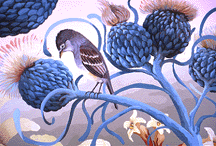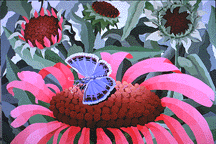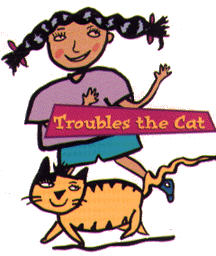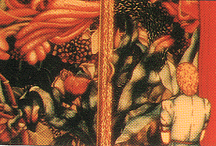Animation
World Magazine, Issue 1.11, February 1997
Suzan Pitt: An Animator's Journey
by Jackie Leger
 Suzan Pitt's Joy Street.
Suzan Pitt's Joy Street.
Susan Pitt's concern for psychological explorations
of the female psyche has been a vital force behind her career for over
25 years. This can be seen in Crocus , one of her early films which
is a surrealist exploration into female sexuality, as well as in Asparagus,
a classic that explores subliminal imagery of the feminine dream,
and in her most recent film Joy Street , her chef d'oeuvre
that relates issues of depression and healing.
For many years, Pitt has been merging the female psyche to her personal
creative projects in such areas as painting, performance art, and theater
design, as well as animation. One might say that she is a Renaissance woman.
While the deep dark depths of the psychology of being are rarely brought
out in animation, Pitt can, in this respect, be associated with pioneer
animator Winsor McCay. His early comic strip/film Dreams of a Rarebit
Fiend probed inner world dreams as masterpieces of whimsy, imagination,
wit and nightmares, depicting human fears and delusions. With films full
of observations and insights, both McCay and Pitt aimed to give relevance
to their characters. Pitt has often criticized the animation business as
avoiding the main goal of story telling, which is having something relevant
to say.
 Suzan Pitt's Joy Street.
Suzan Pitt's Joy Street.
An Eerie Doll House
Susan Pitt grew up in Kansas City, Missouri and relates much of her imagery
to an eerie doll house found in an attic of an old house, where she would
climb dark stairs to get to this miniature, imaginary world. This doll
house became her own private theater, where she created stories which later
influenced her films.
Pitt's creative career began at Cranbrook Academy of Art, where in 1965
she received her BFA in Painting. Like many of her generation, she began
filmmaking with a hand held 8mm camera; transferring some 200 drawings
onto film. One of her early pieces in 16mm Bowl, Theater, Garden, Marble
Game made use of cutout images arranged in a semiabstract form. A recipient
of many grants and an avid teacher, she began her most important formative
years with the completion of Crocus, a surrealistic study and an
ode to the feminine dream and the natural world. Many of her films were
developed in collaboration with her students, a fact which Pitt considers
an important part of her artistic development. The success of such early
films as A City Trip , Jefferson Circus Songs and
Cels , made with students at the Minneapolis College of Art
and Design, brought her recognition and gave her the experience needed
to produce larger projects.
Asparagus is the now classic film that secured Pitt's reputation as
a major American animator. After taking four years to make, Asparagus,
completed in 1979, won awards around the world, including First Prize at
the Oberhausen Film Festival in Germany and awards at Ann Arbor, Baltimore
and Atlanta Film Festivals in the US. Designed like a Pandora's box, the
film opens up the depth of Pitt's own inner psyche, merging sensual and
surrealistic imagery in the form of a Freudian dream. Focusing on erotic
metaphors and intellectual references, she makes this matted-cel work a
visionary masterpiece.
 Suzan Pitt's Joy Street.
Suzan Pitt's Joy Street.
Expanded Cinema
By the late 1970's, Pitt was involved in the Expanded Cinema movement which
led her to merge performance art with animation. Pitt's introduction to
this art form was developed in a course she taught in 1976 at Harvard's
Carpenter Center entitled Loops. In the class, she had her students deconstruct
animation to analyze all of its parts. This exercise grew into a large
animated/live show that included people as cartoons, experimental imagery
from rear screen projection, and drawing on soundtracks. These early endeavors
expanded her work into the world of real space and time, which grew into
many more performances. In 1980, Pitt presented a performance at the Venice
Biennial entitled Suone e Immagine, set to the music of Richard
Teitelbaum Also in 1980, she createdWindow, a three dimensional
interior and film installation commissioned and exhibited by the Institute
of Contemporary Art in Philadelphia. And in 1985, she created ESO-S,
a two screen performance with live music by John and Evan Laurie done at
the Pyramid Club in New York.
Continuing her painting career, Pitt exhibited widely with a solo exhibition
at the Denise Rene Gallery in Dusseldorf and the Delahuty Gallery in New
York, as well as several group exhibitions. These led to an invitation
to created the sets, costumes and animation forThe Magic Flute, an
experimental opera created by the avant-garde director Nicholas Lehnhoff
. After doing projections for this unconventional New Age production from
1983-87, she designed the sets for Richard Foreman's Symphony for Rats
in New York. Lehnhoff then engaged her again for his production of Berlioz'The
Damnation of Faust for the State Opera of Hamburg, a large budget production
in a high-end theater, with an hour of animation and effects interspersed
throughout the three hour performance.
 Suzan Pitt's Joy Street.
Suzan Pitt's Joy Street.
Joy Street
During the 1990s, Pitt's work became focused on the natural environment
and political activism, in particular rain forest activism. These activities
and her travels to exotic places like Guatemala, Belize and Mexico had
a major impact on her career and her most important personal film Joy
Street . Made in 1995, it has been acclaimed at every major
film festival from Hiroshima to London, and all those in between.
Traveling through Guatamala in 1993, she began painting lively images of
animals and birds with color and fantasy, very much influenced by natural
settings of the rain forests. These evolved into images in Joy Street
. During this time, she also received several commissions for paintings,
including a mural for the US Post Office in Fountain City, Wisconsin, and
a series of silkscreens for Artists for Nature, an activist group in Germany
exhibited at the Earth Summit in Rio de Janiero in 1992.
Analyzing Joy Street, one might say it is the culmination of Pitt's
life as an artist and a woman. The images begin like a German Expressionist
nightmare of a woman depressed by the concrete world she lives in. Set
to the haunting music of The Jazz Passengers, this visual poem relates
a sort of psychodrama of a plight which in fact touches the life of many.
Saved from this bad dream by an animated mouse (and what a mouse!), Pitt
develops the second part of the film as an ode to the great classics of
animation, with all the dynamism and pacing of a 1930s Fleischer cartoon.
She blends her personal aesthetic with all the pizzazz of a master animator.
The energy of the mouse, whirling with joy and innocence, and the deep
pain of the woman make a truly interesting movie experience. Pitt's statement
throughout the film reflects the passing of nature and innocence as a road
to depression and emptiness.
Today, Pitt continues to travel and present her work at festivals and universities.
She often gives a lecture entitled "Cartoon Wilderness," which
discusses parallel histories of film animation, and wilderness exploration
and exploitation. This program was recently presented at the Virginia International
Festival, with the theme of "Wild Places/Endangered Species."
She also recently directed Troubles the Cat, 12 different six-minute
sequences produced by The Ink Tank for the Cartoon Network educational
series, Big Bag, which explore issues of ethnicity and self-awareness.
Pitt is now one of the directors represented on the roster of The Ink Tank
Too, a new division of The Ink Tank in New York. Pitt's activism, diversity
and creativity will keep her work relevant well into the next millennium.
Suzan Pitt Animation Filmography
 Troubles the Cat, directed
by Pitt for The Ink Tank, which she has recently signed a long-term agreement
with as part of its Ink Tank Too operation.
Troubles the Cat, directed
by Pitt for The Ink Tank, which she has recently signed a long-term agreement
with as part of its Ink Tank Too operation.
Animated Films
The following films, except when noted,
were produced and directed by Pitt. All were in color, except where noted.
